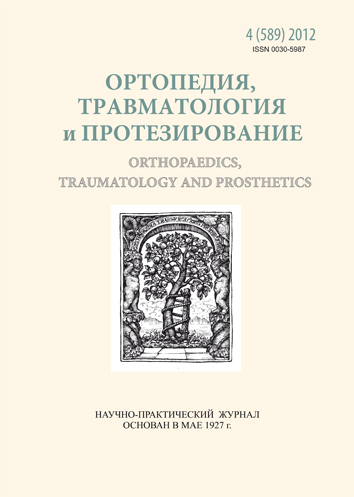Prevention of thromboembolic complications in replacement arthroplasty with use of enoxiparin
DOI:
https://doi.org/10.15674/0030-59872012499-103Keywords:
endoprosthesis replacement, anticoagulant, thromboembolic complications, hip jointAbstract
Replacement arthroplasty is connected with a high risk of complications, deep vein thrombosis and pulmonary embolism being the most dangerous of them. Today low molecular weight heparins are regarded as the «gold standard» for preventing venous thromboembolic complications in case of orthopaedic interventions. The purpose of the present work was as follows: to study the effect of enoxiparin on the haemostasis system and assess its possible use in patients after total hip joint arthroplasty. Indices of clinical and biochemical analyses of blood and urine and coagulogrammes were estimated. The drug did not produce any negative effect on the indices of clinical and biochemical analyses of blood and urine. A higher content of the intravascular thrombopoiesis marker – reaction of the fibrin-monomer complex, fibrinolytic activity, D-dimer – was revealed. Anti-factor Xa activity was at the level, recommended for high risk patients. Hence, enoxiparin at a dose of 40 mg subcutaneously once a day improves indices of the haemostasis system during the postoperative period, does not cause any side or adverse effects and can be recommended for preventing thromboembolic complications in patients after hip joint arthroplasty.References
- Фракционированные и нефракционированные гепарины в интенсивной терапии / Г. В. Дзяк, Е. Н. Клигуненко, В. И. Снисарь, В. В. Ехалов. — Киев, 2005. — 96 с.
- Папаян Л. П. Д-димер в клинической практике. Пособие для врачей / Л. П. Папаян, Е. С. Князева. — Москва, 2002. — 20 с.
- American Academy of Orthopaedic Surgeons clinical guideline on prevention of pulmonary embolism in patients undergoing total hip or knee arthroplasty / N. A. Johanson, P. F. Lachiewicz, J. R. Lieberman // G. Am. Acad. Orhtop. Surg. — 2009. — Vol. 17. — P. 183–196.
- A meta-analysis of thromboembolic prophylaxis following elective total hip arthroplasty / K. B. Freedman, K. R. Brookenthal, R. H. Fitzgerald // J. Bone Joint Surg. — 2000. — Vol. 82-A. — P. 929–938.
- Geets W. H. Prevention of venous thromboembolism: the seveth ACCP Conference on antitrombotic and thrombolytic therapy / W. H. Geets, G. F. Pineo, J. A. Heat // Chest. — 2004. — P. 338–400.
- Prophylaxis for thromboembolic disease: recommendations from the American College of Chest Physicians—are they appropriate for orthopaedic surgery? / J. J. Callaghan, L. D. Dorr, G. A. Engh et al. // J. Arthroplasty. — 2005. — Vol. 20. — P. 273–274.
- Risk factors for venous tromboemolism in patients undergoing total hip replacement and receiving routine tromboprophylaxis / A. B. Pedersen, H. T. Sorensen, F. Mehnert // J. Bone Joint Surg. — 2010. — Vol. 92-A, Issue 12. — P. 2156–2164.
- Preoperative or postoperative start of prophylaxis for venous thromboembolism with low-molecular-weight heparin in elective hip surgery? / N. Strebel, M. Prins, G. Agnelli, H. Buller // Arch. Intern. Med. — 2002. — Vol. 162 (13). — P. 1451–1456.
Downloads
How to Cite
Issue
Section
License
Copyright (c) 2014 Volodymyr Filipenko, Frieda Leontyeva, Olga Podgayskaya

This work is licensed under a Creative Commons Attribution 4.0 International License.
The authors retain the right of authorship of their manuscript and pass the journal the right of the first publication of this article, which automatically become available from the date of publication under the terms of Creative Commons Attribution License, which allows others to freely distribute the published manuscript with mandatory linking to authors of the original research and the first publication of this one in this journal.
Authors have the right to enter into a separate supplemental agreement on the additional non-exclusive distribution of manuscript in the form in which it was published by the journal (i.e. to put work in electronic storage of an institution or publish as a part of the book) while maintaining the reference to the first publication of the manuscript in this journal.
The editorial policy of the journal allows authors and encourages manuscript accommodation online (i.e. in storage of an institution or on the personal websites) as before submission of the manuscript to the editorial office, and during its editorial processing because it contributes to productive scientific discussion and positively affects the efficiency and dynamics of the published manuscript citation (see The Effect of Open Access).














